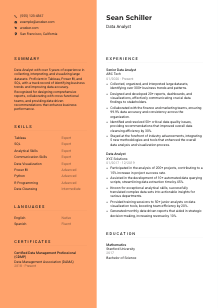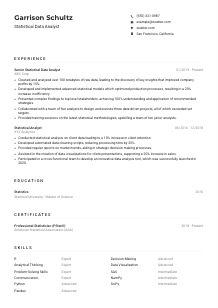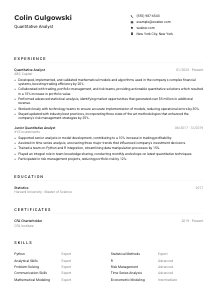Data Analyst CV Example
Delving into datasets, but your CV feels like raw, unfiltered data? Navigate this Data Analyst CV example, shaped with Wozber free CV builder. Discover how to present your analytical insights and statistical savvy in a structured format, making your career trajectory trend with the data you analyze!

How to write a Data Analyst CV?
Hello, aspiring Data Analyst! The path to securing your dream job in the world of data is paved with one crucial document - your CV. Fear not, for with the right guidance, creating a CV that not only ticks all the boxes but also stands out is entirely achievable. By leveraging the power of Wozber's free CV builder and following industry-best practices, you're about to craft a CV that speaks volumes of your expertise in data analysis.
Ready to unlock the secrets to a CV that opens doors? Let's set forth on this journey, equipped with Wozber's ATS-friendly CV template and ATS optimisation.
Personal Details
The gateway to your CV, the Personal Details section, might seem innocuous, but it's a potent introduction to your professional persona. Here's how to master this section for a Data Analyst role, ensuring it's not only precise but resonates with the job you're eyeing.
1. Make Your Name Your Brand
Your name is the beacon that guides employers through your CV; ensure it shines bright. Opt for a clear, readable font, setting the stage for your professional narrative ahead. Your name is the marquee; let it set the expectation.
2. Clearly State Your Objective
Directly beneath your name, articulate your career objective. For a Data Analyst role, lean into your knack for unraveling data's stories, transforming insights into actionable strategies. This upfront declaration positions you as a focused candidate.
3. Essentials: Contact Information
Accuracy is key in data and your CV. List your contact details with meticulous care, ensuring your phone number and a professional email address (preferably firstname.lastname@email.com) are typo-free, presenting you as detail-oriented and reliable.
4. Geographical Relevance
"Must be located in San Francisco, California." This job's location requirement is non-negotiable. Echo this in your CV to confirm your eligibility, removing any doubts about relocation or remote work preferences right from the start.
5. Digital Proficiency
In an era where digital presence speaks volumes, including a link to your LinkedIn profile or a personal website showcasing your projects or portfolio resonates with the digital-savvy nature of a Data Analyst. Keep it updated and reflective of your CV.
Takeaway
Consider the Personal Details section as the opening chapter of your professional story. Craft it with intent, ensuring each element, from your name to your contact details, aligns seamlessly with the Data Analyst role you aspire to secure.





Experience
The Experience section is your battleground, where you'll showcase your victories and achievements. For a Data Analyst position, it's crucial to mirror the job requirements with your past roles elegantly. Dive in to see how your experience can reflect your suitability for the role.
- Collected, organized, and interpreted large datasets, identifying over 300+ business trends and patterns.
- Designed and developed 20+ reports, dashboards, and visualizations, effectively communicating crucial data findings to stakeholders.
- Collaborated with the finance and marketing teams, ensuring 99.9% data accuracy and consistency across the organisation.
- Identified and resolved 50+ critical data quality issues, providing recommendations that improved overall data cleansing efficiency by 30%.
- Stayed at the forefront of industry advancements, integrating 5 new methodologies and tools that enhanced the overall data analysis and visualization process.
- Participated in the analysis of 200+ projects, contributing to a 15% increase in project success rate.
- Assisted in the development of 10+ automated data querying scripts, streamlining data extraction time by 45%.
- Known for exceptional analytical skills, successfully translated complex data sets into actionable insights for various departments.
- Provided training sessions to 50+ junior analysts on data visualization tools, boosting team efficiency by 20%.
- Generated monthly data‑driven reports that aided in strategic decision‑making, increasing revenue by 10%.
1. Match the Job Description
Start with a surgical approach, dissecting the job description. Highlight phrases like "Collect, organize, and interpret large datasets" and align your past job responsibilities directly with these tasks. This direct correlation showcases your perfect fit.
2. Chronological Clarity
Arrange your roles in reverse chronological order, with an emphasis on recent positions. This structure is not only ATS-friendly but also allows recruiters to trace your professional growth and expertise accumulation in data analysis.
3. Achievement Spotlights
Illuminate your accomplishments with metrics where possible. Translating complex data into actionable insights for a business? Mention how your efforts led to a tangible improvement, such as a revenue increase or cost reduction. Concrete achievements are memorable.
4. Quantify Success
Data speaks, and so should your CV. Whenever possible, quantify your contributions. Example: "Identified and resolved 50+ critical data quality issues, improving overall data cleansing efficiency by 30%." Numbers add weight and credibility to your achievements.
5. Relevance is Key
While that latte art competition might be a fun fact, keep your CV laser-focused on your data analysis prowess. Filter your experiences to spotlight skills like SQL, Python/R, and data visualization, directly echoing the job's demands.
Takeaway
The Experience section is your narrative arc, detailing how you've evolved into the Data Analyst role you seek. By tailoring each bullet point to reflect the job description, you turn your CV into a compelling narrative that resonates with hiring managers.
Education
Your academic background is more than a list of degrees; it's the foundation of your knowledge and skills. For a Data Analyst role, aligning your education with the job's requirements demonstrates you're well-equipped for the challenges ahead.
1. Align with Job Specifications
Reflect on the educational prerequisites: "Bachelor's degree in Mathematics, Statistics, Computer Science, or related field." Ensure your degree, mentioned prominently, mirrors these specifications, showcasing your eligibility from the get-go.
2. A Structure of Clarity
Maintain simplicity in presenting your educational journey. Start with the most recent and relevant education, listing your degree, the institution, and your graduation year. This clarity helps in ATS optimisation and eases the recruiter's job.
3. Degree Relevance
Having a degree directly related to the role, such as a Bachelor of Science in Mathematics, is a golden ticket. It directly checks a major box in the job requirements, positioning you as a prime candidate right off the bat.
4. Course Highlights
If your degree is a close match but not a direct hit, or if you're aiming to showcase specialized knowledge, listing relevant courses can bolster your CV. Highlight any coursework in SQL, Python/R, or statistical analysis that aligns with the job's demands.
5. Beyond the Classroom
Any extracurricular accomplishments like participation in data hackathons, relevant workshops, or seminars add depth to your profile, showing a proactive engagement with your field beyond academic requirements. These are especially appealing for early-career data analysts.
Takeaway
Your Educational section is a testament to your readiness and qualification for the Data Analyst role. By aligning it closely with the job's demands and complementing it with relevant extracurriculars, you present yourself as a well-rounded, ideal candidate.
Certificates
In the ever-evolving field of data analysis, staying ahead with the latest certifications can make all the difference. Let's navigate through the process of making your Certificate section as impactful as possible for a Data Analyst role.
1. Job Description Insights
While the job might not list specific certifications, including relevant ones like 'Certified Data Management Professional (CDMP)' demonstrates your commitment to professional growth and expertise in data management, catching the employer's eye.
2. Relevance Over Quantity
Rather than listing every certification you've ever earned, prioritize those that directly align with the skills required for a Data Analyst role. This laser focus ensures that hiring managers see exactly what makes you a strong fit for the position.
3. Dates Matter
Including the dates for your certifications, especially for ones that are current or recently achieved, signals to employers that you are up-to-date with the latest trends and methodologies in data analysis, which is vital in a rapidly evolving field.
4. A Commitment to Learning
Data analysis is a field that constantly shifts and grows. By regularly updating your certifications and highlighting your commitment to continuous learning, you signal your agility and readiness to adapt, traits highly valued in any Data Analyst.
Takeaway
The Certificates section is your opportunity to flaunt your ongoing commitment to professional development. Handpicked to reflect the demands of a Data Analyst role, these certifications make a compelling case for your candidacy.
Skills
The Skills section of your CV is where you get to boast about the tools and methodologies you're proficient in. For a Data Analyst, this is where your technical prowess meets data storytelling. Let's make sure it shines.
1. Job Description Decoder
Starting point? The job description. Extract skills like 'Strong proficiency in SQL and Python/R for data querying and analysis' and 'Proficiency in data visualization tools such as Tableau or Power BI.' These are your keywords, make sure they're prominently featured.
2. A Curated Toolkit
In a sea of possible data analysis tools and techniques, focus on listing those most relevant to the job at hand. Expert in Tableau? Python wizard? Don't just list these skills - claim your prowess and demonstrate how they've been pivotal in your accomplishments.
3. Organisation is Key
Resist the urge to overload this section. A cluttered Skills section can dilute your strengths. Group your skills into categories like 'Data Visualization', 'Data Mining', etc., for readability and to make it easier for hiring managers (and the ATS) to spot your expertise.
Takeaway
Treat the Skills section as your professional arsenal. Be precise, be proud, and present a curated list that demonstrates you're not just competent but excel in the realms crucial for a Data Analyst. The clearer your skills, the brighter you shine in the hiring spotlight.
Languages
As a Data Analyst, your ability to communicate complex insights is as important as your analytical prowess. Your language skills can give you an edge, particularly in diverse or international settings. Let's optimise this section to reflect your communicative strength.
1. Essential Proficiency
"Strong English communication skills needed." This isn't just a requirement; it's your stage to convey complex data analysis in a language clear to all stakeholders. Highlight your proficiency in English and any additional languages that can enrich your role.
2. Prioritizing Relevance
Start with the languages most pertinent to the job. If the role has a global or multicultural aspect, showcasing your linguistic diversity can be a unique selling point. Fluent in English and Spanish? Make sure these are listed, with your level of fluency clearly marked.
3. Comprehensive Listing
Even if additional languages aren't explicitly required, they can signify your ability to thrive in a global team or deal with international data sets. List them, but always with an honest appraisal of your proficiency level.
4. Clarity in Proficiency
Be transparent about your language skills. From 'Native' to 'Basic', providing a clear indication of your proficiency helps set expectations and can avoid any misunderstandings down the line.
5. The Bigger Picture
Languages are more than just words; they're keys to unlocking new perspectives and insights. A Data Analyst proficient in multiple languages can navigate cross-cultural datasets with ease, providing richer, more nuanced analyses.
Takeaway
Your proficiency in languages is a testament to your ability to communicate in a connected world. As a Data Analyst, this skill enhances your capability to present data-driven insights across cultures, making you a valuable asset to any team.
Summary
Your CV summary is not just an overview; it's your professional headline, your pitch that captures your essence as a Data Analyst. Here's how to craft a summary that captures attention and vividly articulates your unique value proposition.
1. Capture Your Essence
Begin with a crisp statement that encapsulates your professional identity. 'Data Analyst with over 5 years of experience in collecting, interpreting, and visualizing large datasets' instantly frames your expertise and sets the stage for what follows.
2. Showcase Your Specialties
Immediately follow up with a highlight of your key skills and achievements. Bring in specifics from the job requirements, such as your proficiency in Tableau, Power BI, and SQL, and how you've effectively translated data into actionable business strategies.
3. Be Succinct, Yet Impactful
Your summary should be a tightly woven narrative, not exceeding three to five lines. It's your elevator pitch - make every word count by focusing on what makes you a standout candidate for the Data Analyst role.
4. Summarize with Confidence
Conclude your summary with a strong closing statement that reaffirms your eagerness and readiness for the role. Express confidence in your abilities to harness data for insights and decisions, compelling the recruiter to delve deeper into your CV.
Takeaway
Think of your CV summary as the hook that will capture the hiring manager's interest. Tailored precisely to the Data Analyst role, it underlines your readiness to translate complex data into clear, actionable insights. Let your summary be the spotlight that guides the recruiter through your professional narrative.
Launching Your Data Analyst Journey
Congratulations on taking this critical step towards securing your next role as a Data Analyst! Armed with these insights, your CV is now not just a document, but a testament to your skills, experiences, and ambition. Let Wozber's free CV builder, ATS-friendly CV template, and ATS CV scanner be your allies on this journey. Your ability to analyze, interpret, and visualize data has the power to influence decisions and strategies.
Now, with a CV that perfectly encapsulates these capabilities, the path to your dream job is clearer than ever. Go forth, confident in your ability to make an impact with data!

- Bachelor's degree in Mathematics, Statistics, Computer Science, or related field.
- Minimum of 3 years of experience in data analysis, preferably in a business setting.
- Proficiency in data visualization tools such as Tableau or Power BI.
- Strong proficiency in SQL and Python/R for data querying and analysis.
- Excellent analytical skills with the ability to translate complex data into actionable insights.
- Strong English communication skills needed.
- Must be located in San Francisco, California.
- Collect, organize, and interpret large datasets to identify trends, patterns, and opportunities for the business.
- Design and develop reports, dashboards, and visualizations to effectively communicate data findings to stakeholders.
- Collaborate with cross-functional teams to ensure data accuracy and consistency.
- Identify data quality issues and provide recommendations for data cleansing and standardization.
- Stay updated on the latest industry trends, tools, and methodologies for data analysis and visualization.















